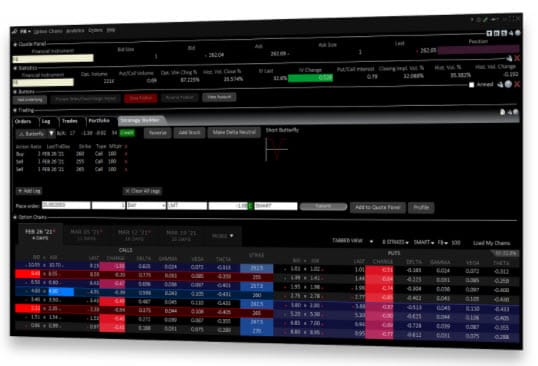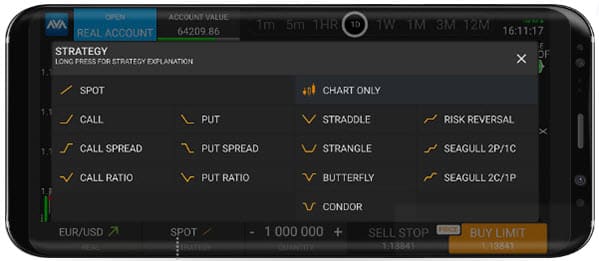For investors in every field, hedging against the unknown and the inherent risks in their core business should be the ultimate goal.
In professional trading, options trading strategies are one of the most important trading methods to both create profit and minimize risks.
Options are extremely versatile. Profits can not only be generated by directional trades, i.e., by correctly “predicting” the market direction, but also by speculating that the market will not fall below a certain price.
This guide explains what options are and how options work. We’ll also look at concrete examples to understand how options work and how they can be used.
NOTE: You can get your free options trading strategies PDF below.
What Are Options?
One option is a conditional futures contract.
The buyer of an option has the right, but not the obligation, to buy or sell a particular underlying asset at the expiration date or during the term at a pre-agreed price.
The seller of an option has – in the case of the exercise of the option by the buyer – the obligation to deliver the underlying asset at the pre-agreed price (in the case of a call option) or to buy the underlying asset (in the case of a put option).
By buying an option, you buy the right to either buy or sell a specific underlying asset at a specific time and a pre-defined price.
Options transactions are often referred to as futures transactions. The most important feature of options is that with the purchase of the option, only the right to buy or sell is acquired, but not the obligation to execute this option.
If this sounds even more complicated, don’t worry. The way options work is straightforward to understand. We’ll break it down throughout this guide.
What is a Stock Option?
You do not purchase a share with a stock option, but only the ‘option’ to purchase.
A stock option entitles the holder to purchase shares of a particular public limited company to buy or sell at a fixed value. It means that stock options are not valid indefinitely but have an expiry date.
Options do not represent their inherent value, but they are always derived from an underlying asset – in the case of stock options, the underlying asset is a company’s share.
The option reacts over time to changes in the price of the underlying asset.
Although an option, unlike a share, does not constitute a stake in a company, it allows the purchase or sale of such a company.
The difference with direct stock trading is that the price is already fixed, although the transaction date is in the future.
How do Stock Options Work?
There is always a seller (still holder) and a buyer (owner) in option transactions.
The seller can only wait and see how the underlying asset develops. Hence the term still holder. In return, he receives an option bonus. It is the remuneration for the seller’s obligation. The buyer, on the other hand, can become active.
Depending on the option, he can decide during the term or at the end of the term (expiry date) whether to let the option expire or exercise it.
- If an option expires, the seller receives his premium – the buyer receives nothing.
- If an option is exercised, the seller may demand the surrender or acceptance of the underlying asset. Simply put, the seller receives his premium and has to buy or buy the share from the buyer.
Types of Stock Options
The two biggest differences between options are how they are exercised and the business process.
The exercise variant determines when an option can be exercised, and the business process determines whether an option entitles you to buy or sell a share.
Distinction According to the Type of Exercise
In practice, the American and European options are at odds with each other.
- American options are characterized by the fact that they can be exercised throughout the holding period.
American Options grant the holder the right to exercise the option at any time during its term.
The buyer can also buy the underlying asset before the maturity date, at the strike price (if it is a call option), or sell it (if it is a put option). Whether this always makes sense for the option holder (e.g., due to a high time value and further profit potential) remains unclear.
The possibility of exercising these options at any time also increases the premium to be paid because the seller wishes to be adequately compensated for this obligation.
- European options are only be exercised on the predetermined expiry date. A European option is an option contract that can only be exercised at the end of the term. Even if the underlying asset has risen above the strike price or fallen below it, the option cannot be exercised prematurely. The only decisive factor is which price the underlying asset shows at the maturity date of the option.
On the pre-defined due date, the buyer (owner) of the option can thus exercise the associated right.
In the case of a call option, he could buy the underlying asset at a fixed price; in the case of a put option, he could sell it. The seller of the option (silent partnership holder) must then issue or accept the corresponding underlying asset in the event of exercise. However, for this risk, the seller is compensated with the option premium. If the option is not exercised, this is his profit.
Distinction According to the Business Process
In the case of stock options, a distinction can be made between call and put options. Both call and put options can be sold and sold.
Calls benefit from an increase in the share price, puts from a decline.
- A call option grants the buyer the opportunity to buy the underlying asset. Once the option is exercised, the call option seller must hand over a defined amount of shares to the buyer at a set price. A call option is usually exercised if the share price is above the strike on the exercise date.
- A put option gives the buyer the chance to sell the underlying asset. When exercising the option, the seller must purchase shares from the stock option buyer at the agreed price. The exercise will be exactly the other way around than with the call option. So, if the share price is below the strike (the share has dropped in value), the exercise is worthwhile. The buyer of the option can now sell his stock for more money than it is currently worth.
Advantages of Stock Options
Options can be used in a variety of ways in the economic and financial world.
For banks, companies, and private individuals, this derivative is interesting.
Bonus / Remuneration
Managers of listed companies often receive bonuses in options from the employer and their normal salary. It means that the manager benefits when the share price of the company rises.
Usually, the price of a share rises with the positive company development and with good figures. The manager or board of directors should thus be interested in a long-term increase in value. Compared to the usual options, these options often have very long holding periods.
If a manager has now managed successfully, he can exercise his options and buy shares in the company. However, this is much cheaper than the current price. Thus, in addition to the salary and direct bonuses, he makes even more profit.
Hedging
This is perhaps the most common use for stock options. If an investor is unsure about the performance of a stock position, he can hedge it with an option by the option behaving exactly opposite to the share price.
The investor must pay the option premium for this. However, there is no longer any risk if prices collapse.
Stock options are traded in contracts. One contract corresponds to 100 shares of the underlying.
When hedging the deposit, therefore, only one option per 100 shares should be purchased. No pure hedging effect is guaranteed. Incidentally, this strategy is called Protective Put.
Trading / Cash Flow
Of course, options are often also used in trading to profit from rising or falling prices.
Particularly interesting is the leverage effect of the derivatives. Because the option premiums are significantly lower than the equivalent of 100 shares (1 contract), more profit can be generated with little money. However, the risk is also increased.
For income investors, the cash flow on an existing portfolio can be interesting.
For example, with covered calls, more can be extracted from a stock portfolio than just dividends and price gains. The custodian can then collect additional option premiums. It is also possible when starting to invest.
Options Trading Strategies Cheat Sheet
Now that we understand what stock options are let’s look at some of the most popular options trading strategies for beginners.
Covered call
In practice, this is of the most used strategies.
In the covered call strategy, you buy securities for a specific underlying asset and at the same time sell a (short) call option over the same value. You cover the open position in the option through the paper in your depot.
The option investor can earn an additional return using a Call option writes, whose strike above the underlying asset’s course.
Since the investor owns the underlying, the written call option is covered.
The income on the covered call comes exclusively from the option premium. However, you will only benefit from this return if the price value of the security at the maturity of the option is very close to the exercise value.
If the price rises, you are obliged to sell more valuable security at the agreed price. If the price falls, the holder of the option will let his options right expire. However, you must bear the loss due to the lowered price.
Married Put
This options trading strategy is also called the protective put.
With a protective put, you cover the risk of a stock position falling. You buy a Put option on a share that you have in your portfolio. That is, the passing of time is a disadvantage for you. The paid option premium is comparable to the premium for insurance to cover a risk. The maximum loss of the position is due to the difference between the purchase price of the shares and the strike the put option and the paid option premium.
This method thus differs from the simple long put, which can also be bought without the underlying asset.
If the price of the underlying drops lower than the strike price, the put can be exercised in profit. This strategy is ideal for price hedging of stock positions.
With the Protective Put, two factors determine the amount of the premium. First, the difference between the option’s exercise price and the share price impacts the amount of the option premium. The further the put option is out of the money, the lower the option premium. The second important factor is the runtime of the option.
Straddle
The straddle consists of a combination of two options. One put, and one call are traded. Due to the two opposing options, only larger price swings change something in the profit/loss of the position.
Depending on whether the options have been sold or sold, the options trader speculates on rising or falling volatility.
The influence of implied volatility plays a big role in straddles.
A short straddle strategy benefits from falling volatility. As a result, the prices of the options fall, and a buyback of the position is cheaper than the premium paid at the beginning. For a long straddle, the options trader is the owner of the option and benefits from an increase in value.
Long Straddle
Here, both call and put options are purchased simultaneously.
The strategy starts at a loss because two premiums had to be paid. The loss for this cannot increase any higher. For the strategy to generate profit, however, significant price movements are necessary. The direction of the movement is irrelevant.
The strategy is profitable regardless of the price direction.
Short Straddle
Both call (short call) and put options (short put) are sold on the same underlying asset, with the same strike and maturity date.
A short straddle obliges the options trader to buy or sell a stock at a set price, provided that one of the two options contained is tendered.
The option premium received is higher than on its own with a short call or short put by selling two options.
Long Strangle
A strangle options trading strategy has a lot in common with the straddle strategy.
The long strangle involves buying a call option (long call) and buying a put option (long put) of the same underlying asset with the same expiry date.
Remember, for the Long Straddle, different strikes are chosen. Since the options are usually out of money, the long strangle is cheaper. In return, the price increase or drop must be even stronger than with a long straddle to generate profit.
The fundamental objective of this strategy is also to benefit from changes in the share price in both directions.
The cost of a long strangle is comparatively high compared to other strategies. It is suitable for volatile stocks.
Short Strangle
Here, a put option with strike A (short put) and a call option with strike B are sold (short call).
The underlying asset price should be between strike A and B on the due date for maximum profit. Both options are ideally worthless.
The option premium received is higher than on its own with a short call or short put by selling two options.
Experts in options trading use this strategy, just like a short straddle, to benefit from falling implied volatility. In market phases with high volatility, the options may be overvalued. The goal is to close the position at a profit as soon as volatility drops.
Bull Call Spread
The bull call spread, also known as “long call spread”, “bull call debit spread” or “long call vertical spread”, is formed with the purchase of a call option (long call) to strike A and by the sale of a call option (short call) to a higher strike B on the same underlying asset.
The option premium received for the sale of the call option compensates for the cost of purchasing the option.
The strike of the sold call is above the strike of the bought call.
This strategy limits the risk. In return, the maximum profit is also limited and not unlimited, as with the long call.
The basis of the long call spread strategy is:
- Buying a call option, strike A on an underlying asset
- Choice of strike A usually at or slightly below the current share price (in the money)
- Selling a call option, strike B on the same underlying asset
- Choice of strike B usually above the current share price (out of the money)
Both options have the same due date.
Bear Put Spread
A bear put spread, also known as “long put spread”, or “long put vertical spread”.
The strategy involves selling puts (short put) to a strike A and buying puts (long put) at a higher strike price B on the same underlying asset. The spread has the same number of puts with the same expiration date.
Selling a cheaper put with strike A helps to reduce the cost of the purchased put with Strike B. In turn, the potential gain of this strategy is limited.
The basis of the bear-put spread strategy is:
- Sale of a put option, strike A on an underlying asset
- Choice of strike A usually below the current stock price (out of the money)
- Buying a put option, strike B on the same underlying asset
- Choice of strike B usually above the current share price (in the money)
Protective Collar
The Collar option strategy is a mixture of a covered call and a protective put on the same underlying asset.
A put is bought to sell the underlying asset – for example, a share – at Strike A. The sale of the call option goes hand in hand with the obligation to sell at Strike B. Within this framework, the option premium for the call option compensates for the cost of the put.
Here’s how to set it up:
- Purchase or possession of at least 100 shares
- Buying a put option with Strike A
- Selling a call option with Strike B
- Strike of the put below, a strike of the call above the current share price
Both options must have the same expiration date.
How to Minimize Risk With Options
To effectively explain how you can minimize risks with options, we’ll have to use some practical examples.
We’ll use the covered call strategy since it is one of the most used options trading strategies.
This strategy is recommended for slightly bearish, neutral to bullish market opinion and the willingness to sell the shares if necessary.
To execute this strategy, you must:
- Purchase or already in possession of the underlying asset
- Selling a call option
- Choice of strike usually higher than the current share price
Remember that a call option gives the right to buy a particular underlying asset at a future date and a fixed price.
In this example, the following transactions were performed:
- LONG: 100 shares for $40 per share
- SALE: A Call option $42
For the sale of the call option, the investor receives $1 in premium, which puts the breakeven price at $39. If the underlying stock closes above $39, you make a profit, with a maximum profit of $300. If the stock closes below $39, then you record a loss.
The breakeven point is equal to the strike minus the option premium. Thus, it is usually below the price at the time of sale.
The sweet spot of a covered purchase option depends on the seller’s goals.
Lastly on Options Strategies
For beginner investors, stock options might be overwhelming.
This guide has equipped you with the knowledge of relevant options trading terminologies and easy-to-implement option strategies for every market phase.
In the end, you should only trade options depending on the market circumstances and expectations.
NOTE: You can get your free options trading strategies PDF below.

Stelian is an aggressive, success-driven, and highly collaborative entrepreneurial trader with 13 years of experience trading within financial markets.
Stelian is a disciplined investor with a passion for trading and a solid understanding of global markets.



